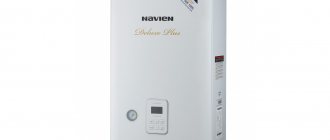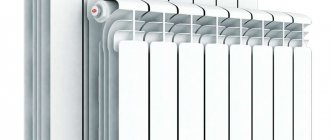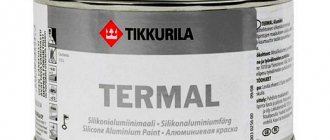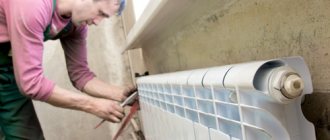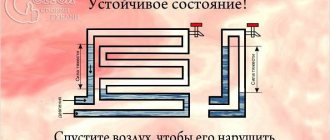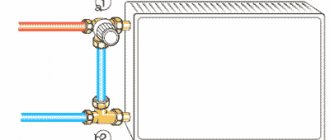Other reasons
The most popular reason is a decrease in the coolant flow rate. There are several options why this problem occurs:
- Narrow pipe section. Narrowing of the pipe can occur due to improper soldering of the pipes. This applies to polypropylene pipes. Another possible cause could be the presence of any deposits in the pipe. A common problem encountered is the installation of a control valve with a narrowed cross-section;
- In a heating system, the coolant moves at low speed. This problem occurs when the power of the circulation pump is low. In this case, the water does not move at the required speed and cannot go into the layer. This problem mainly occurs in gravity systems, in which there is no additional equipment;
- Low temperature in the house. In this case, the radiator cools faster, as it gives off a large amount of its energy. Therefore, the bottom of the radiator becomes colder than the top.
To identify the cause, the condition of the entire heating system should be assessed and checked. Once a problem is detected, it must be corrected for further normal operation of the radiator.
Breakage of shut-off valves
Shut-off valves are designed to completely or partially cut off the coolant supply to the batteries. Its main components include :
- Ball Valves;
- valves;
- thermal heads equipped with a mechanical or automatic adjustment system.
Ball valve design
The bottom of the battery is cold and the top is hot due to a malfunction inside the tap. This may be due to a broken valve or any other violation of the correct operation of an element that interferes with the free circulation of fluid. You should also pay attention to the correct direction of valve installation. The manufacturer indicates the direction of water movement on the housing and installation must be carried out according to it. If installed incorrectly, water will not move through the pipe even in the open position of the shut-off valves.
What are the reasons for uneven heating of radiators
Batteries are an essential component of residential heating systems. It is their serviceability that determines how warm the rooms will be. With proper connection and proper operation, radiators can effectively heat the air in large rooms and maintain an optimal temperature for a long time. However, what should you do if the top of the radiator heats up perfectly, but the bottom remains cold? First of all, you need to figure out why this happens.
The part at the bottom of the batteries heats up worse
Let us immediately remind you that most battery models are designed in such a way that during operation their lower part heats up somewhat worse. This can be explained by the high degree of heat transfer - while the water is in the radiator, it has time to cool down a little before it begins to flow out of the batteries. As a result of this principle, the upper part of the device will always become hotter. Thanks to this, there is no need to worry if, during operation of the heating elements, their surface does not heat up completely equally.
It's worse if you touch the device and see a large temperature difference. This directly indicates that the radiator was not connected correctly, or the liquid in it is moving at insufficient speed. In the first option, the professional most likely mixed up the outflow and water supply pipes. Many real estate owners face a similar situation. The basis is the lack of professionalism of the called technician or an attempt to attach the radiator with your own hands. In another embodiment, the bottom of the radiator is cold due to the low speed of water flow in the middle of it. In this case, the liquid can cool completely before flowing out of the element.
Battery installation
After repair or installation work, the batteries may heat up partially, for example, only the upper part or the first 2-3 sections. The reason is an incorrect connection of the radiator.
In most cases, the batteries are connected to the network diagonally - water enters the radiator from the top and exits from the bottom. The state of the device is considered normal when the temperature of the upper and lower parts differs little. A large difference in the heating of the upper and lower parts may indicate an incorrect connection of the hot water pipe. If water is supplied from below and exits through the upper pipe, only the first couple of sections or only its upper part will heat up on the battery.
The lack of hot water in the heat exchanger may be due to the installation by neighbors of batteries with built-in thermostats that are capable of shutting off hot water. The operation of such batteries requires the presence in the system of a bypass pipe (bypass), through which water flows when the thermostat on the radiator is activated. If there is no jumper, the coolant will not flow further than the radiator.
Why is half the battery cold?
In this case, the following situations are considered:
- incorrect connection of the radiator;
When the radiator is not connected correctly.
The main reason why the battery is half cold may be that it is connected incorrectly. According to the rules for installing heating equipment in a heating circuit, the pipe supplying hot coolant must be connected to the top of the battery. The cold pipe or return, on the contrary, is to its lower part. Also read: “Radiator brackets.”
How can we explain this?
You need to take into account the laws of physics and remember that hot water is much lighter than cold water, and therefore is located in the upper part of the heating device. Gradually releasing its thermal energy to the surrounding air, the coolant cools down. Its density, and hence its weight, increases. He goes down. That is why often half of the battery is cold and half is hot.
The difference in pressure at the top and bottom of the radiator causes the coolant to move from top to bottom. If the supply and return pipes are reversed, then the battery only heats up half. In this case, it is necessary to correctly install the heating device.
Why is the bottom of the battery cold and the top hot? — School on home insulation
Batteries and radiators Why is the bottom of the battery cold and the top hot?
Often on construction forums people complain about heating systems - the bottom of the radiator is cold and the top is hot. It is worth noting that any radiator on top is warmer than on the bottom, but if the gap between these temperatures is too large, then most likely there is something wrong with the system. Moreover, this means that the battery produces less thermal energy than it should. After all, everyone knows that the efficiency of heating devices directly depends on the uniform heating of their surfaces.
Today we will try to figure out why this phenomenon occurs and what needs to be done about it.
Reason #6. Cold
There is another possible reason why the bottom of the battery is cold and the top is hot. This can happen in the cold. This can happen if, for example, the heating battery is located in a cold room - on a loggia or, alternatively, in a veranda. And if the air in the room is cold, then the working fluid, accordingly, will cool much faster. Because of this, the bottom of the radiator may also have a lower temperature.
Is there any way to fix the problem?
All that remains is to talk about the most important thing - that is, how such problems are eliminated. First of all, we note that the specific decision depends solely on the reason for which everything happens.
If, for example, the lower pipe of the battery is also cold, then, most likely, during installation the “return” was confused with the supply, which we already discussed in one of the previous paragraphs of the article. In this case, it is necessary to deal with the taps and pipeline. If there is a control valve, the reason most likely lies in its too narrow longitudinal section.
It should also be noted that if the reason for the low temperature in the lower part of the radiator is the low speed of the working fluid, then to solve the problem it is simply necessary to increase it (the speed). To do this, you just need to insert a circulation pump into the main line. Although this, in principle, is not a very correct solution if there is a possibility that the longitudinal section of the pipeline or taps is too narrow. Moreover, this solution will cost much more.
We must not forget that the sequence of actions when searching for the cause of the problem should be thought out at the initial stage of work.
And if the bottom of the battery is cold, while the temperature of the lower pipe is quite high, then the reason in this case lies in the incorrect installation already mentioned above (“the return” was confused with the supply element).
If both the lower pipe and the entire lower part of the battery as a whole are cold, then the only reason can be the low circulation rate of the working fluid in the system. For a more detailed understanding of the problem, we recommend watching the thematic video below.
– The battery does not heat up due to incorrect connection
As a conclusion
As you can see, there are many reasons why the bottom of the battery is cold and the top is hot. The most common of them (and there are only six of them) are given in this article and you have already become familiar with them. As a result, I would like to note that the main thing to remember in the case of such a problem is the correct sequence of actions when searching for the cause, as well as adequate measures to eliminate it.
New bimetallic radiators have a cold bottom while the top is hot - possible reasons
As already noted, for all models the heating of the lower region is weaker than that of the upper. This is explained by the high heat transfer of the bimetal - the water has time to cool thoroughly during the passage. Hence the temperature difference, which worries owners so much.
When not to worry
But with such insignificant differences there should be no reason for concern - this is a normal situation, given the features of this type of device:
- A single vertical channel in each section (for example, cast iron products have two).
- Small channel diameter (little coolant), but effective heat transfer due to the special configuration of the fins.
- Profiled convection channels between the ribs of the sections contribute to enhanced heat transfer, regardless of whether the battery is made by Italian or Russian.
- The thin walls of the sections heat up quickly, but also cool down just as quickly. Therefore, if you have bimetallic radiators at home and the bottom is cold and the top is hot near the appliances, this property needs to be taken into account.
Probable causes of uneven heat transfer
Despite similar trends, each case must be considered individually
If we ignore three important factors: incorrect calculation of the power of the boiler, pump and number of batteries, then we should take into account the likelihood of the following problems:
- Air jams are an inevitable consequence of measures to fill the structure with coolant. An additional symptom is gurgling or hissing sounds. The solution is the installation of a Mayevsky crane.
- Clogging of heating appliances is the result of neglecting regular flushing of the system, especially in apartments with a central heating system.
- Unsatisfactory coolant circulation - if distant heating units do not heat up well, then it is worth considering this reason, in particular in systems with natural circulation. To solve the problem when bimetallic radiators are hot at the top and too cold at the bottom, installing a circulation pump will help.
- Incorrect operation of the heating structure is a fairly common factor when the bypass is not adjusted. Even experienced home craftsmen who know how to properly install a battery with their own hands make mistakes when performing commissioning work.
- Problems with shut-off valves - proper installation of these units does not guarantee that over time the mechanism or electronic components will not fail.
Low temperature
If the difference in the temperature conditions of the bottom and top of the batteries is not too significant, then there is no need to worry. This arrangement of radiators is quite natural. The circulating coolant always has time to cool down a little, which is due to fairly high heat output rates. Very large discrepancies may require system intervention.
If the water temperature in the heating system is low, then it will be necessary to increase the heating of the coolant by increasing the power of the operating heater. A good result is also achieved by using a special heat-reflecting screen. For this purpose, it is recommended to use traditional aluminum foil or modern and reliable material such as penofol.
An important point with a two-pipe connection is the ability to regulate the temperature in a separate battery using special fittings, represented by a conventional shut-off valve. This ensures an increase or decrease in the volume of coolant in each radiator by adjusting the shut-off valves.
Air jams
The presence of air in the system is the main reason why the bottom of the battery is cold and the top is hot. Most often, this nuisance occurs among residents of apartment buildings on the upper floors. The air in the system tends upward, so if you live in the upper part of the building, you should install Mayevsky valves or drains.
You can read about how to bleed air from a cast iron battery here.
Mayevsky crane
The sequence of actions will be as follows:
- Shut off the pipe that supplies hot water to the battery. The “return” must remain open.
- Open the bleeder and wait until the air is completely out of the system.
- Close the drain and resume water supply to the radiator.
In a private house, you can use an alternative scheme:
- Turn off the heating supply.
- Open the drain at the highest point of the heating system.
- Use back pressure to remove any accumulated air.
If these recommendations do not bring the expected result, it is better to call a specialist to diagnose the entire system as a whole.
Air bleeder in new batteries
There is air in the radiator
An air-filled heating system is also ineffective in heating rooms. As a rule, such an unpleasant situation with the accumulation of air bubbles in radiators is observed in apartment buildings on the upper floors, which is easily explained by the elementary laws of physics - air rises towards the roof. Usually such batteries have a cold top, but this does not exclude the fact that there may also be a cold bottom.
For preventive purposes, standard Mayevsky taps are installed, through which all the air accumulated in the radiators is drained from the system. You need to shut off the hot water supply pipe and leave the “return” in the open position, then open the tap and let out the air. After closing the tap, the supply of coolant to the radiator is resumed.
Do-it-yourself troubleshooting (step-by-step instructions)
The reasons for the malfunction of the heating system, indicated by a large difference in the temperature of the top and bottom of the radiator, are considered. It remains to decide on a plan of action when they arise. It should immediately be noted that it is impossible to eliminate some problems on your own. If you feel cold in the room and detect a strong difference in the temperature of the upper and lower parts of the battery, it is necessary to perform a number of measures in order.
Check and fully open the supply and discharge valves on the battery pipes
If a malfunction is detected, it is necessary to replace the failed components of the shut-off valve being repaired or replace it completely if repair is impossible. Bleed the air lock from the battery, if there is a valve or tap, by placing a suitable container for the liquid and being careful. If there is air, water from the tap will burst out in jerks with a characteristic hissing sound. If bleeding the air does not help, you can start checking and, if necessary, cleaning the radiator from internal contamination
After closing the taps on the pipes and placing a suitable container under the radiator, unscrew the drain plug; the presence of contamination will be indicated by a leaking dark brown substance (almost black). If there is no dirt or air, and provided that before the start of the heating season any plumbing work was carried out on the heating system, you should check that the radiator is connected correctly. If you discover incorrect installation yourself or by calling the experts from a home maintenance company, you must bring the installation of the battery in accordance with the approved diagram. If the pressure and circulation rate of the working fluid are low, when all other checks and measures have been carried out, you need to call the management company or the organization supplying heat to find out the time frame for eliminating the problem. If the room is cold, then it is advisable to wait until it warms up; it is possible that during the owner’s absence the central heating was turned off for some reason. As the room warms up, the difference in heating between the top and bottom may return to normal.
The most important thing is to remember safety measures, since hot water under pressure can not only damage the surrounding interior, but also cause harm to health.
Video
The presented video clip shows the process of bleeding air from the radiator.
Insufficient pressure
There may not be enough pressure to push water through the entire heat exchanger.
Poor circulation can cause low blood pressure. If the bottom of the batteries is cold, what should I do? In this case, you need to make sure that the pressure in the system is sufficient. Previously, in Soviet times, cast iron batteries were installed. All passages in them are wide and therefore less pressure was required so that the coolant could pass through the entire heat exchanger. Modern batteries have a slightly different structure.
Often, after purchasing and installing new batteries, people ask the question: “The top of the battery is hot, the bottom is cold, what should I do?” The fact is that the inlet/outlet pipes and the heat exchanger labyrinth itself have a smaller nominal bore. Therefore, in a circuit designed for cast iron, the pressure simply cannot overcome the resistance and push the coolant through the entire heat exchanger.
In addition, the pressure in the system may drop for the following reasons:
- the neighbors “quietly” installed central high-temperature heating;
- neighbors installed a bypass tap;
- neighbors are experimenting with extreme adjustments to their batteries;
- neighbors significantly increased the volume of heat exchangers by adding additional sections;
- problems in the central highway.
Regarding heated floors and radiators, which are several times larger in volume than heat exchangers from the developer, it should be noted that this is illegal. After such manipulations, the pressure in the general system drops, so you shouldn’t be surprised why the bottom of the battery is cold.
On the forums, some “experts” advise installing shut-off valves on the bypass. Then, using the method of partially shutting off the tap, adjust the degree of permeability of the bypass so that the main flow goes to the batteries. But you can’t do that. If the relevant authorities find out, they will fine you and force you to redo it. By the way, if the bypass is too far from the battery, then the circulation in the latter will also be disrupted. And if the bypass is also of the same diameter as the supply line, then even more so.
When deciding what to install in their home, many choose bimetallic radiators. They are not much more expensive than aluminum ones, but last twice as long.
The top of the battery is always warmer than the bottom. However, if this difference is high, this indicates a problem. There are two main reasons:
1. Incorrect connection.
2. Slow movement of the coolant.
Incorrect connection.
This reason is possible with a diagonal connection. The correct option is: feed at the top on one side, return at the bottom on the opposite side. But sometimes, for some reason, everything is done the other way around.
What happens? Hot water entering the radiator does not go through the lower collector (horizontal flow) and then up. Obeying the laws of nature, it immediately strives upward and, passing the upper collector, goes into the return line.
This is also facilitated by lower outlet pressure. Result: in most parts of the device the liquid is almost standing still.
The solution is to redo the connection.
Slow movement of coolant. This can happen due to a low flow area due to:
- inappropriate control valve;
- old clogged pipes;
- improper soldering of polypropylene;
- weak circulation pump.
As a result, the liquid moves in the battery too slowly and by the time it reaches the bottom it has time to cool down.
To solve the problem, there is a temptation to install a powerful pump, but this is not the cheapest way and not very correct. If the circulation pump is excluded (corresponding to power).
The answer will help to find partial dismantling of problematic devices, during which you will be able to see the condition of the pipes, the quality of soldering and the compliance of the tap. The radiator may also be clogged if it has been standing for long enough.
Low pressure
The bottom of the battery may be colder than the top due to insufficient pressure in the system. If the main system is designed for cast iron pipes, then the water supply force in it is quite low. Installing bimetallic batteries means that the coolant is simply not forced through the narrowed passages inside the radiator.
In a private house with a membrane expansion tank, the pressure in the system can be raised manually. Residents of apartment buildings will have to contact their service provider to resolve the issue. Also, repair work may be carried out on the central highway, after which everything will return to normal.
Pressure gauge showing system pressure
Often the bottom of the battery is cold, and the top is hot, which can occur due to unlawful actions of neighbors of an apartment building :
- Installation of water-type heated floors.
- The bypass was mounted on a common heating supply pipe.
- The volume of radiators was increased without the approval of the technicians.
Why does the heating system work poorly in a private house?
There are several reasons why the heating system in a private home does not work well and the room does not warm up enough.
Electric boiler does not heat well
This usually happens due to insufficient boiler power. Its approximate calculation is made based on the norm of one kilowatt for every 10 square meters of area. The resulting value is increased by a quarter if the boiler is used to heat hot water and by another ten percent as a power reserve. There are correction factors that allow you to adjust the final figure in accordance with the climate zone. For the south it is 0.7-0.9, for the middle zone 1-1.5, for the north up to 2.
Photo 3. An example of calculating the power of an electric boiler for private houses and apartments of various types.
Problems in radiators in which coolant circulates
The next two problems are radiators and impaired coolant circulation. In the private sector, purified water is not always used for heating, so the likelihood of blockages and corrosion is higher. Although the pressure allows the installation of aluminum and steel radiators, they must be protected from debris by filters and from wear by an anti-corrosion coating on the inside.
The second reason for poor water flow is an error in setting up the system. To make the adjustment, the pressure is calculated based on the volume of the system, pipes of the appropriate diameter are selected, and the boiler is adjusted.
Heating system is not balanced
With a small amount of water in the system, not all radiators warm up equally. The problem is solved by hydraulic balancing, which will ensure the passage of different amounts of liquid through each device. The adjustment can be made if the system has bypass and balancing valves, as well as pressure flow regulators.
If the top of the radiator is hot and the bottom is cold, modular balancing is used. To do this, the network is divided into separate elements (one battery, a group of batteries, a riser, etc.) and equipped with a balancing valve. This device allows you to individually configure each module.
During repair work, remember that the water in the system is hot and under high pressure. If you are not confident in your own abilities, call a mechanic from a service organization.
Hello, I have a private house, central heating, but the house is cold, the radiators only heat up halfway from the top, what is the reason? Water pressure is 4-5, temperature is 48-55 degrees, thank you
Hello.
Let's start with the fact that any battery in the upper zone should be noticeably warmer, this is normal. But if the bottom of your radiators is completely cold, this indicates that the heating system is not functioning properly.
Unfortunately, you did not consider it necessary to indicate in your question the data necessary for our experts to fully assess the situation. Namely:
- What is the radiator connection diagram? Where are the coolant inlet and outlet located, are there any bypasses?
- Are control devices installed at the inlet and outlet of heating devices: thermostats, ball valves, valves?
- What wiring scheme is used in your home: one-pipe, two-pipe, combined?
- Was the bottom of the radiators always cold, did it become so immediately after starting the heating system? Or has the problem appeared recently? If so, did the difference in heating between the top and bottom of the batteries appear suddenly or did it happen gradually?
- How are the heating mains entering the house? Is it direct or does it have a heat exchanger?
- Have you recently made any changes to your heating system? If yes, which ones?
Without knowing the answers to these questions, we can endlessly wonder why the batteries do not heat up, pointing our finger at the sky. After all, there can be many reasons for uneven heating of radiators. Here are the most common ones, which may apply to your situation:
The system is airy. Three quarters of complaints about poor heating performance are due to this reason.
It is highly desirable that air venting devices be installed not only at the highest points of the heating system, but also on each radiator. For cast iron batteries, there are also end caps with threads for the Mayevsky tap. We advise you to frequently check the presence of air in the system and bleed it if necessary.
- There may be a pressure difference between the supply and return lines. If there are valves installed at the entrance and exit to the house, check that the return valve is not closed. It could also become clogged. Pressure differentials can also be created outside your home.
- Radiators are not connected correctly. If the pattern is vertical or diagonal, the feed should be located at the top.
On the left is the optimal radiator connection diagram. The coolant, passing through the heating device, inevitably cools down, but at the same time gives off maximum thermal energy. On the right - incorrect connection, the coolant passes along a short path and only the upper part of the battery and one side section are heated.
- The internal diameters of the valves (if any) are incorrectly selected or they are covered.
- The pipelines are installed with narrowings; individual sections of pipes or sections of batteries are clogged or clogged with deposits or scale.
Let us repeat, there can be many reasons. To identify the real one, we need to know a lot more than what you told us.
Heating system efficiency
- The main reasons for uneven heating
- How can this be dangerous?
- Ways to solve the problem
The main reasons for uneven heating
Batteries are an integral element of the room heating system, and the comfort of operation of residential and public buildings or various industrial buildings depends on its serviceability.
The most common reasons for uneven heating of heating radiators are: insufficient power of the circulation pump;
- failure to comply with slopes and angles during the installation of the pipeline system;
- incorrect thermostat mode; air lock;
- battery distortions.
Correct calculations of the power of the heating boiler, as well as commissioning of the heating system, are of no small importance. Consider the fact that a slight temperature difference between the lower and upper parts is not a deviation
You should worry about a significant decrease in heating, it negatively affects the efficiency of the radiator
Please note that a slight temperature difference between the lower and upper parts is not a deviation. You should be concerned when the heating decreases significantly; it negatively affects the efficiency of the radiator.
How can this be dangerous?
The uniform heating of radiator batteries directly depends on the balance of the speed of the coolant and its temperature regime.
Incorrect operation of the heating system can cause:
- quite strong and unpleasant noise and vibration;
- disturbances in the acid-base balance of the thermal fluid;
- increasing the corrosive effect on heating elements;
- noticeable reduction in service life, as well as failure of batteries.
Ways to solve the problem
Not all heating system problems can be solved on their own. However, there are ways to bring radiators into working position.
To eliminate uneven heat output, you must perform the following steps:
- Bleed air from the heating system.
- Install an automatic air release valve.
- Install a circulation pump of sufficient power.
- Adjust the bypass.
It is important to annually flush the radiators and core, which very often become clogged during operation. If you cannot achieve uniform, stable heating of the radiator batteries on your own, then you should not delay in inviting qualified plumbing workers who can cope with problems of any level of complexity. published econet.ru
If you cannot achieve uniform, stable heating of the radiator batteries on your own, then you should not delay in inviting qualified plumbing workers who can cope with problems of any level of complexity. published econet.ru
If you have any questions on this topic, ask them to the experts and readers of our project here.
Experts explain why the batteries are cold and the riser is hot
You can't warm your hands on cold radiators.
There can be many reasons why the coolant supply pipe is hot and the radiator is cold. For general development, specialists name only the main ones:
- the central valve on the heat supply line is closed or the return line is closed;
- insufficient coolant flow;
- airing of the system or a specific riser, radiator;
- the heating system is not balanced;
- contamination in the heating circuit;
- reducing the cross-section of the coolant supply pipe.
However, the following actions by the residents of the house will help the technicians who come to the call to quickly eliminate the malfunction of the heating circuit:
- Is it necessary to install a hot pipe and a cold radiator in only one apartment or does this problem affect the entire riser. Perhaps the heating wiring of the entire entrance is faulty;
- it doesn’t hurt to go around all the entrances and see if the heating elements are hot there;
- you can go down to the basement and inspect the pipes for breakdowns. Even a drip leak leads to a drop in pressure in the system. This adversely affects her work.
All information received should be passed on to specialists. However, there are situations when the organization involved in heating the house refuses to repair the wiring. In this case, residents must contact regulatory authorities with a complaint about poor quality services. Also read: “Where should I go if the batteries don’t heat up?”
Everything you need to know about filling your heating system with antifreeze can be found here.
Device for cleaning the circuit.
If the batteries do not heat up the riser. If the riser is cold, the battery is cold - this is a sure sign that the main line through which the coolant flows is blocked. To confirm this, you need to walk through the neighboring apartments. They should warm up well. In this case, only a plumber, who will have drawings of the heating wiring of the house, can fix the breakdown.
The following state of affairs, when the pipe is hot and the battery is cold, indicates a blockage in the system or the presence of an air lock. It prevents the penetration of coolant into the heating element. As a result, the latter does not warm up. Blockages can only be eliminated if you completely disassemble the radiator and force air through it under pressure. This can only be done by a specialist who has the necessary tools and equipment.
It is easy to eliminate an air lock that prevents the full circulation of coolant in the system. For this purpose, each radiator is equipped with a Mayevsky tap. It is enough to open it slightly and let out some hot water. Along with it, unnecessary air will come out. Also read: “What to do if the batteries don’t heat up?”
All the nuances that you may encounter when installing an electric boiler in a heating system are described at this link.
If the radiators in the entire entrance do not heat
When the heating radiator is cold and the riser is hot, you need to pay attention to the pressure in the circuit. If the pressure is insufficient, the coolant cannot pass through all the radiators in the circuit
As a result, the batteries lower their temperature as they move away from the heat-carrying main. Residents of the house cannot increase the pressure in the system on their own, and therefore it is recommended to seek help from professionals. More specifically, call the organization that is responsible for the heat supply of the building.
The supply and return may be reversed.
Residents of a new house, when starting up the heating system for the first time, may observe the following situation: the battery is cold and the return is hot. Here it is appropriate to assume that errors were made when installing the heating elements. In this case, the pipes supplying coolant and the return circuit are swapped. If we are talking about an individual heating circuit, then it is worth taking a closer look at the circulation pump. It may not be installed correctly.
When asked why there is cold return in the radiators, experts clearly point to an incorrectly designed heating system. In some cases, it is appropriate to talk about low coolant flow.
How to clean clogged batteries?
To avoid a situation where the radiators are cold on the bottom and hot on the top, they need to be cleaned periodically:
- To clean the radiator, it will have to be removed and washed. The best place for this would be the street or the bathroom.
- If you plan to clean the bathroom, protect the drain from blockages and the bathroom from scratches.
- Turn off the water, remove the radiator, drain all the liquid.
- To remove the rust, tap the battery through a thick cloth, then shake out the debris.
- It would be a good idea to rinse the battery with a pressure hose to properly clean it of accumulated rust.
- For prevention, you should clean all radiators in the apartment, and not just those where the lower part of the radiator is cold and the upper part is hot.
- Be careful when cleaning the battery. If you doubt that you can handle this work, it is better to contact a specialist.
Now you know what to do if the top of the battery is hot and the bottom is cold. On our website you can find out where to complain in Moscow about cold radiators in your apartment.
What to do if the batteries are clogged
A clogged heating radiator is a common problem when operating batteries, which leads to various troubles. Dirt accumulates inside the devices due to poor quality coolant and the presence of air. This is especially true at the beginning of the heating season. When heating starts and stops, look here.
In self-contained circuits that do not rely on central heating, dirt and debris can enter through an open hydraulic tank. Particles and batteries settle at the bottom and in the nooks and crannies of the battery, resulting in disruption of coolant circulation. The batteries begin to heat up worse. A severe blockage leads to the fact that the radiators become completely or half cold.
Clogging also occurs due to the accumulation of excess air and the formation of an air lock. Modern bimetallic batteries are easy to maintain. In this case, you can remove excess air by opening a special tap. If the problem is an air lock, a hiss will follow from the hole. If the problem is different, coolant will flow from the tap. In this case, immediately close the tap.
For old cast iron batteries such a faucet is not provided. If there is an air lock, you will have to look for the coupling, which is located at the connection of the pipe with the approach to the radiator. Turn the coupling and dirty coolant will flow out of the tap. Drain a little and twist back. To avoid staining the floor, place a container under the coupling first. Do not unscrew the coupling completely, otherwise there is a risk of flooding!
Pressure regulator
Many homes have water pressure regulators. Usually they are in the basement. Some models maintain constant pressure, others are adjustable. Sometimes the regulator may be part of the heat meter.
If it is incorrectly configured or broken, the pressure in the riser may change. At the same time, the temperature of the radiators in all apartments will also change. If the regulator is adjustable, you can try increasing the pressure. After this, the temperature of the radiators should increase.
If the water regulator is not adjustable, you will not be able to test it yourself. It's better to contact specialists. You will not be able to check and repair it yourself.
In this publication, we looked at the main reasons why the heating pipe is hot and the radiator is barely warm. In 95% of cases, the article will help identify and solve the problem. If nothing suits you, call a specialist. We hope the publication was useful. Don't forget to share it with your friends!
Insufficient water pressure in the system
As you know, all heating systems are divided into two main types: gravity (gravity) and forced. In the latter case, a water pump is installed, which drives the coolant through the pipes, thereby ensuring uniform heating of the radiators throughout the house.
In the gravitational scheme, movement is achieved due to the difference in density of cold and hot water. In this case, the boiler should be installed at the lowest point, and the expansion tank at the top. This option for installing a heating system can answer the question of why one battery is hot and the other is cold. The thing is that hot water warms up radiators located in close proximity to the boiler, while those located far from it lack coolant movement and do not heat up.
The solution in this case would be to install a circulation pump, which will provide additional acceleration to the hot water moving through the pipes. It is better to perform the installation through a bypass; this will allow, in the event of a breakdown, to remove the device without draining the system and stopping the heating.
Basic malfunctions of heating systems and their elimination
Air jams
Air pockets occur in radiators and pipes and interfere with the normal circulation of water in the heating system. They appear for various reasons:
- violation of the technology for filling the system with water after the summer period;
- non-compliance with water deaeration regime;
- performing repairs with disassembling pipelines;
- failure to observe slopes when installing the heating system;
- air leakage through leaky joints.
To remove air from the system, use a Mayevsky valve installed on the radiator. You should open it, wait until the air comes out, the hissing stops, and the water begins to pour out calmly without bubbles. After this, the valve is closed. Don't forget to provide a container or towel to drain the water.
Old cast iron batteries do not have Mayevsky taps. The air is released without completely unscrewing the plugs at the ends of the radiators. It is better to entrust this operation to plumbers - if you unscrew the plug completely, you can flood the apartment.
In the cold season, the main thing is good heating. Unfortunately, not all houses in winter remain at a comfortable level.
This applies to both multi-apartment housing and the private sector. Why is this situation happening and what to do?
